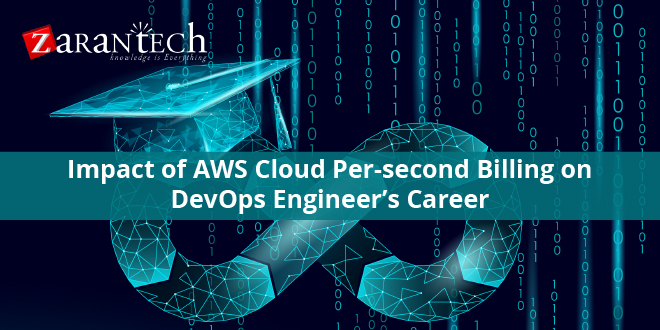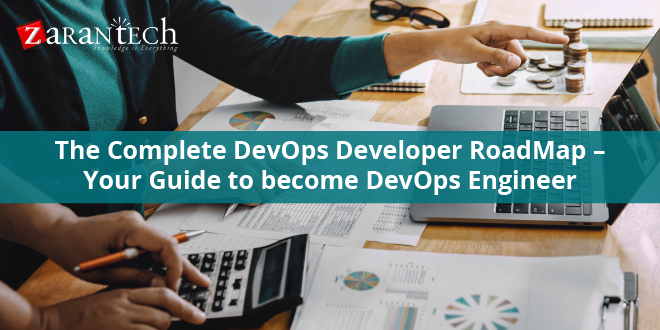Impact of AWS Cloud Per-second Billing on DevOps Engineer’s Career
Category: DevOps Posted:Dec 08, 2017 By: Serena Josh Amazon introduced AWS services in 2006 with per-hour billing model for compute resources was a turning point for the IT world. Since then, AWS stands as an eminent leader in the cloud computing market, while broadening the range of cloud services offered every year. But the per-hour billing Business model was one of the major issues for many customers – in particular, those who had applications using EC2 for only minutes at a time. AWS is an inclusive and evolving cloud computing platform delivered by Amazon, it gives a set of Software as a Service, Platform as a Service, and Infrastructure as a Service beneficiaries.
Amazon introduced AWS services in 2006 with per-hour billing model for compute resources was a turning point for the IT world. Since then, AWS stands as an eminent leader in the cloud computing market, while broadening the range of cloud services offered every year. But the per-hour billing Business model was one of the major issues for many customers – in particular, those who had applications using EC2 for only minutes at a time. AWS is an inclusive and evolving cloud computing platform delivered by Amazon, it gives a set of Software as a Service, Platform as a Service, and Infrastructure as a Service beneficiaries.
Recently, AWS announced support for per-second billing of its EC2 service, addressing the aforementioned concerns. Of course, this also created controversy among the per-hour supporters. While I won’t get into the pros and cons across the whole enterprise, one group in particular is affected from the new per-second model: DevOps Engineers.
Amazon Web Services provides services from dozens of data centres spread across availability zones (AZs) in regions across the world. An AZ represents a location that typically contains multiple physical data centres, while a region is a collection of AZs in geographic proximity connected by low-latency network links. An AWS customer can spin up virtual machines (VMs) and replicate data in different AZs to achieve a highly reliable infrastructure that is resistant to failures of individual servers or an entire data centre. More than 100 services comprise the Amazon Web Services portfolio, including those for compute, databases, infrastructure management, application development and security.
Amazon Web Services has a wide-range of Business productivity SaaS options. The Amazon Chime service enables online video meetings, calls and text-based chats across devices. A business can also take advantage of Amazon WorkDocs, file storage and sharing service, and Amazon WorkMail, a business email service with calendaring features. Desktop and streaming application services include Amazon WorkSpaces, a remote desktop-as-a-service platform, and Amazon AppStream, a service that lets a developer stream a desktop application from AWS to an end user’s web browser.
AWS also has a variety of services that enable internet of things (IoT) deployments. The AWS IoT service provides a back-end platform to manage IoT devices and data ingestion to other AWS storage and database services. The AWS IoT Button provides hardware for limited IoT functionality, and AWS Green grass brings AWS compute capabilities to IoT devices.
Here are the top four implications for DevOps teams as a result of per-second billing:
Auto scale without worrying about cost
Most engineers were varying of auto scaling at will, due to EC2’s hourly charges even though they might require additional calculation capacity for just fifteen minutes. With per-second billing, DevOps Engineers don’t have to worry it’s as simple as scaling your EC2 instance as you need to, and when you need to.
There is no need of custom logic for hourly batches
Most of the customers use EC2 for jobs and Batch Processing Purposes. Because of hourly pricing, Engineers built custom logic to benchmark and constantly tuned the number of nodes in their batch clusters to ensure they are cost-optimized. Per-second billing releases complexities for DevOps Engineers that implement EC2 for job clusters and Batch processing.
Plight of Lambda or EC2
Be prepared to differentiate it’s good to imply Lambda or EC2 for new workloads and applications more often used. You’re gauging between Lambda and EC2 has turned out to be dicey. The server less lambda just got competition from EC2 again.
Your big data just got easier
With EMR also supporting per-second billing, your job has become a lot easier. As a , you no longer need to constantly benchmark your EMR clusters for number of nodes and job processing times to be optimized for per-hour billing.
The Conclusion
DevOps Engineers can benefit a lot from per-hour billing, but there is a lot to consider when it comes to time-to-deployment and choosing a compute service. To make a smooth transition to the new AWS Business model it is the time for DevOps Engineers in bringing these concerns to their CIOs.
I hope that by now you have had an overview of DevOps. Before you enroll in ZaranTech’s certification course on DevOps, do check out the DevOps demo:




 99999999 (Toll Free)
99999999 (Toll Free)  +91 9999999
+91 9999999